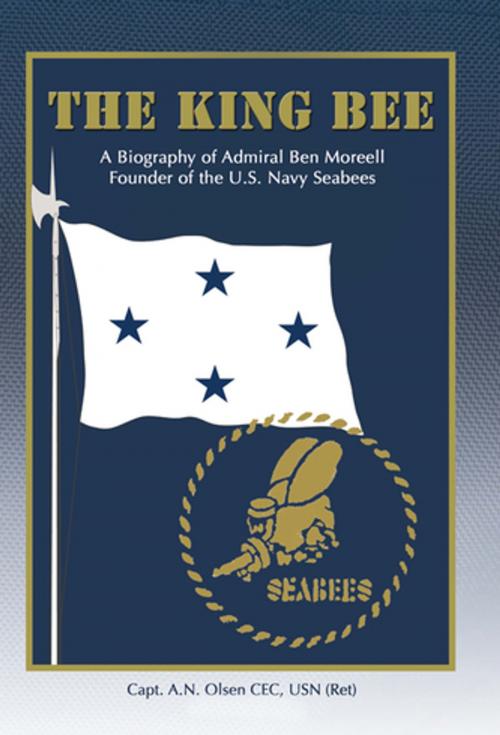| Author: | A. N. Olsen | ISBN: | 9781612511085 |
| Publisher: | Naval Institute Press | Publication: | November 24, 2011 |
| Imprint: | Naval Institute Press | Language: | English |
| Author: | A. N. Olsen |
| ISBN: | 9781612511085 |
| Publisher: | Naval Institute Press |
| Publication: | November 24, 2011 |
| Imprint: | Naval Institute Press |
| Language: | English |
Ben Moreell was the first non-Naval Academy graduate to be awarded the four stars of an Admiral. He is still the only staff corps officer to be promoted to Admiral. The history of the U.S. Navy Seabees and the biography of Admiral Ben Moreell are inseparable. Immediately after the Japanese attack on Pearl Harbor, he began forming the construction units that ultimately became known as the Seabees. The first battalion of Seabees deployed from the U.S. on 27 Jan. '42. This instantaneous effort to recruit, train, organize, equip and deploy a military unit is still recognized as an amazing achievement. Ultimately over 300,000 Seabees were involved during WW II.
The Seabees built and operated the equipment needed to get troops, equipment and supplies ashore in every amphibious landing of WW II. Beginning in North Africa and continuing to Sicily, Italy and Normandy, they were an essential element of the invasions of Europe. But their island hopping campaign throughout the Pacific with the Marines really made their reputation.They participated in every Pacific invasion together with the Marines with the exception of Guadalcanal, where they arrived about three weeks after the First Marines went ashore. Following the invasions, the Seabees built every sort of facility required by the Marines and the Navy; piers, runways, fuel storage, hospitals, ammo storage, dry docks, and more. The accomplishments of the Seabees continued through Korea, Viet Nam and the middle east.
The unique aspect of the fighter-builder Seabees generated a need for a command structure that could respond to both elements at any time. Recognizing this critical feature Moreell achieved a major change to Navy Regulations and obtained the authorization for Civil Engineer Corps officers to be given command of the Seabees. They are still the only staff corps officers who enjoy the privilege of commanding fleet units.
Moreell also directed the massive mobilization and construction effort for the Navy and Marine Corps throughout the war as well as dealing with unions, congress, manufacturers, and an ever growing federal bureaucracy. His open and honest dealings were recognized by all and contributed to the successful accomplishments of the Bureau of Yards and Docks during that time.
But it Seabees remain his crowning military achievement.
Their success in W W II was recognized by Fleet Admiral Chester Nimitz in a Seabee birthday anniversary letter to Moreell in which he stated, "....without them we could not have beaten the (Japanese)."
An advisor to four Presidents, Ben Moreell's actions forever placed the Civil Engineer Corps and the Seabees solidly in Navy history and tradition.
The Seabees built and operated the equipment needed to get troops, equipment and supplies ashore in every amphibious landing of WW II. Beginning in North Africa and continuing to Sicily, Italy and Normandy, they were an essential element of the invasions of Europe. But their island hopping campaign throughout the Pacific with the Marines really made their reputation.They participated in every Pacific invasion together with the Marines with the exception of Guadalcanal, where they arrived about three weeks after the First Marines went ashore. Following the invasions, the Seabees built every sort of facility required by the Marines and the Navy; piers, runways, fuel storage, hospitals, ammo storage, dry docks, and more. The accomplishments of the Seabees continued through Korea, Viet Nam and the middle east.
The unique aspect of the fighter-builder Seabees generated a need for a command structure that could respond to both elements at any time. Recognizing this critical feature Moreell achieved a major change to Navy Regulations and obtained the authorization for Civil Engineer Corps officers to be given command of the Seabees. They are still the only staff corps officers who enjoy the privilege of commanding fleet units.
Moreell also directed the massive mobilization and construction effort for the Navy and Marine Corps throughout the war as well as dealing with unions, congress, manufacturers, and an ever growing federal bureaucracy. His open and honest dealings were recognized by all and contributed to the successful accomplishments of the Bureau of Yards and Docks during that time.
But it Seabees remain his crowning military achievement.
Their success in W W II was recognized by Fleet Admiral Chester Nimitz in a Seabee birthday anniversary letter to Moreell in which he stated, "....without them we could not have beaten the (Japanese)."
An advisor to four Presidents, Ben Moreell's actions forever placed the Civil Engineer Corps and the Seabees solidly in Navy history and tradition.
Ben Moreell was the first non-Naval Academy graduate to be awarded the four stars of an Admiral. He is still the only staff corps officer to be promoted to Admiral. The history of the U.S. Navy Seabees and the biography of Admiral Ben Moreell are inseparable. Immediately after the Japanese attack on Pearl Harbor, he began forming the construction units that ultimately became known as the Seabees. The first battalion of Seabees deployed from the U.S. on 27 Jan. '42. This instantaneous effort to recruit, train, organize, equip and deploy a military unit is still recognized as an amazing achievement. Ultimately over 300,000 Seabees were involved during WW II.
The Seabees built and operated the equipment needed to get troops, equipment and supplies ashore in every amphibious landing of WW II. Beginning in North Africa and continuing to Sicily, Italy and Normandy, they were an essential element of the invasions of Europe. But their island hopping campaign throughout the Pacific with the Marines really made their reputation.They participated in every Pacific invasion together with the Marines with the exception of Guadalcanal, where they arrived about three weeks after the First Marines went ashore. Following the invasions, the Seabees built every sort of facility required by the Marines and the Navy; piers, runways, fuel storage, hospitals, ammo storage, dry docks, and more. The accomplishments of the Seabees continued through Korea, Viet Nam and the middle east.
The unique aspect of the fighter-builder Seabees generated a need for a command structure that could respond to both elements at any time. Recognizing this critical feature Moreell achieved a major change to Navy Regulations and obtained the authorization for Civil Engineer Corps officers to be given command of the Seabees. They are still the only staff corps officers who enjoy the privilege of commanding fleet units.
Moreell also directed the massive mobilization and construction effort for the Navy and Marine Corps throughout the war as well as dealing with unions, congress, manufacturers, and an ever growing federal bureaucracy. His open and honest dealings were recognized by all and contributed to the successful accomplishments of the Bureau of Yards and Docks during that time.
But it Seabees remain his crowning military achievement.
Their success in W W II was recognized by Fleet Admiral Chester Nimitz in a Seabee birthday anniversary letter to Moreell in which he stated, "....without them we could not have beaten the (Japanese)."
An advisor to four Presidents, Ben Moreell's actions forever placed the Civil Engineer Corps and the Seabees solidly in Navy history and tradition.
The Seabees built and operated the equipment needed to get troops, equipment and supplies ashore in every amphibious landing of WW II. Beginning in North Africa and continuing to Sicily, Italy and Normandy, they were an essential element of the invasions of Europe. But their island hopping campaign throughout the Pacific with the Marines really made their reputation.They participated in every Pacific invasion together with the Marines with the exception of Guadalcanal, where they arrived about three weeks after the First Marines went ashore. Following the invasions, the Seabees built every sort of facility required by the Marines and the Navy; piers, runways, fuel storage, hospitals, ammo storage, dry docks, and more. The accomplishments of the Seabees continued through Korea, Viet Nam and the middle east.
The unique aspect of the fighter-builder Seabees generated a need for a command structure that could respond to both elements at any time. Recognizing this critical feature Moreell achieved a major change to Navy Regulations and obtained the authorization for Civil Engineer Corps officers to be given command of the Seabees. They are still the only staff corps officers who enjoy the privilege of commanding fleet units.
Moreell also directed the massive mobilization and construction effort for the Navy and Marine Corps throughout the war as well as dealing with unions, congress, manufacturers, and an ever growing federal bureaucracy. His open and honest dealings were recognized by all and contributed to the successful accomplishments of the Bureau of Yards and Docks during that time.
But it Seabees remain his crowning military achievement.
Their success in W W II was recognized by Fleet Admiral Chester Nimitz in a Seabee birthday anniversary letter to Moreell in which he stated, "....without them we could not have beaten the (Japanese)."
An advisor to four Presidents, Ben Moreell's actions forever placed the Civil Engineer Corps and the Seabees solidly in Navy history and tradition.















